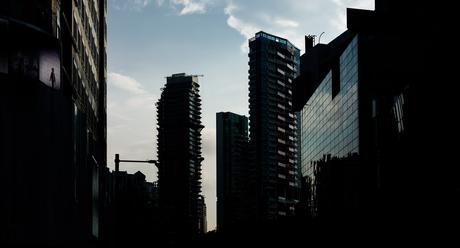
Fujifilm GFX50S, Fujinon 32-64mm F4 at 64mm. 1/3200 at F8, ISO 400. My favourite GFX shot, one of the best cityscapes I have made in Singapore. Shot handheld in motion while walking across an intersection. I only discovered later, that there was an ad featuring a person on the large screen top left. Lucky punch!
There is a fine tradition of street and documentary work using film medium format cameras – but none of the digital medium format cameras have seemed very usable for this purpose. That may change with the new generation of mirrorless medium format cameras. Fujifilm WOW’ed the camera world at Photokina 2016 by revealing the Fujifilm GFX system, a new compact and affordable mirrorless medium format system.
I first briefly held the GFX50 camera at Photokina 2016, sitting with most of Fujifilm Nordic in a small meeting room inside this Matrix style backstage secret mini-universe at the Fujifilm booth. I was truly amazed that compared to any other digital medium format camera I have seen, this was just a normal DSLR sized camera. I looked through the viewfinder, shot a few shots, but quickly passed it on. The room was filled with photographic legends who all had a lot of film medium format experience – so I had no business holding this thing for too long!
I have only a little experience with medium format, film and digital. I know quite a few photographers who own the latest digital medium format cameras and while I have tried them for 10 minutes, I have never been interested in those cameras at all. They are insanely expensive and they are all big clunky, often unstable, squarish beasts that are no good in low light – that means they are completely unsuitable for my work. If you like a good chuckle and a trip back in time to one of my really old very silly posts, I once goofed around with a digital medium format Hasselblad H3D-39 for a weekend in 2008.
I also spent many months in 2008 shooting with the Fujifilm G617 panoramic medium format film camera. This was a fantastic learning process and you can read all my G617 posts here (unfortunately most of the pictures are missing from the posts). I do love the medium format look (especially on grainy imperfect film I must admit). From time to time I have entertained the idea of a film medium format camera, but film is just not practical for a nomad with no home living on the road. Enter, the GFX, a compact mirrorless camera that works in low light!
Gypsy Factor X. My experiences with the Fujifilm GFX50S
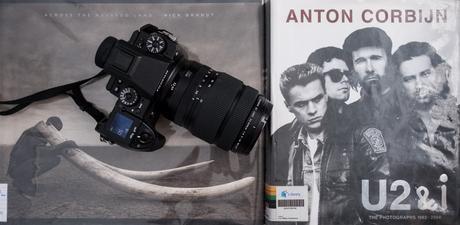
GFX courtesy of Fujifilm Singapore and books from two legendary photographers who actually know how to use medium format courtesy of the Singapore library.
Disclaimer: Yes, I use the Fujifilm X-series cameras exclusively now (on year 6) and am an official Fujifilm X-Photographer and that is why I was able to try the GFX. Charlene and I are nomads, but belong to the wonderful Fujifilm Nordic division in Scandinavia (my home turf). But since we always spend some time every year in her home country of Singapore, we have come to know the great people of Fujifilm Singapore as well. After attending their big GFX launch event here in Singapore, Favian Loo from Fujifilm Singapore very generously offered me and Charlene to loan not one but two GFX cameras and all 3 available lenses for a week. Incredibly exciting, and I am humbled and happy to be an X-Photographer and have an opportunity to try a camera I could never in a lifetime afford to buy. I will always write exactly what I want and feel like on my blog though, and this post is definitely not a review. I could win the title of world’s worst camera reviewer hands down easily! Nor do I make any recommendations, just observations.
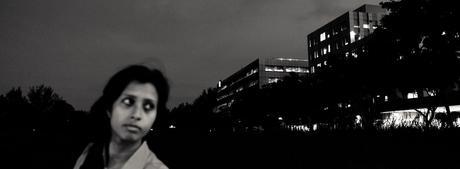
Fujifilm GFX50S, Fujinon 32-64mm F4 at 32mm. 1/35 at F4, ISO 12800. Corbijn style portrait of The Magic One and I LOVE walking around shooting at the 65:24 panoramic crop setting, it is like having a Panavision movie camera view inside the EVF. Way too much fun!
I am not interested in any kind of technical perfection nor pixel peeping, nor am I a studio or portrait shooter. I am purely interested in exploring how the medium format look can be used for my work – such as the portrait of Charlene above. I want to toy with all the new possibilities like a kid, be in the learning zone and just dare to play, do “silly” things with it such as happily shoot the GFX handheld, out of focus and at very high ISO. I take my work seriously but I do it in a merry way.
Note: No RAW converter can read the GFX files yet, so it is jpeg only for now, but those jpegs oh wow! They are absolutely insanely gorgeous. I have sharpness at -4 and noise reduction at -4 just so you know, I dislike any form of sharpening and I really like the high iso grain of the Fujifilm cameras so I leave it all in there. I dislike digital perfection, so sometimes I even add more grain in Lightroom.
Singapore with the GFX
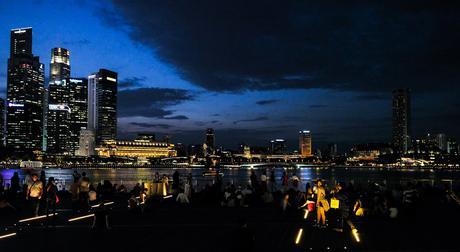
Fujifilm GFX50S, Fujinon 32-64mm F4 at 32mm. 1/120 at F4, iso 12800. Singapore, Marina Bay sands. Handheld, I am using the flip screen and holding the camera over my head. It is really cool to use a medium format camera with just as much freedom as my other X-cameras. And it handles ISO 12,800 really well!
We spent a few days wandering around different areas of Singapore using the GFX just like our other X-cameras – walking and shooting documentary and street pictures and all of it handheld. I am not a street shooter at all, Charlene is the master of this, so I am just shooting random documentary stuff that catches my eye.
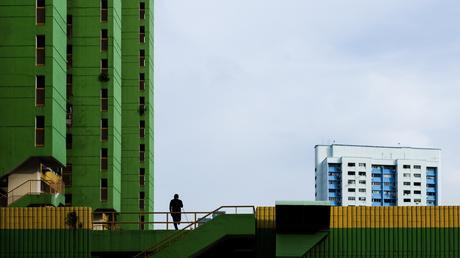
Fujifilm GFX50S, Fujinon 32-64mm F4 at 64mm. 1/1600 at F8, ISO 400. Just a random scene at Chinatown.
The camera is more than responsive enough for street and documentary, and really, it feels like using an X-T1, just bigger. I use either back button focus or manual focus, and for my use I find the autofocus is fast. Then there is the files! Even handheld at high iso, the files that the GFX produces are mind boggling. They are incredibly detailed without being overly sharp or digital with hard edges, they have a 3 dimensional look and are simply gorgeous. As mentioned we cannot process RAWs yet, but the jpegs that the GFX camera produces are outstanding, I barely touch them in Lightroom. I could seriously shoot jpeg only on the GFX except for unpredictable light situations such as concerts and nightclubs.
A GFX is overkill for this kind of work for me, but there is no doubt at all in my mind that you can use the GFX for street and documentary work. And you are rewarded with outstanding image quality, even at very high iso. Walking around for hours and hours, I do find the camera starts to feel a bit heavy. But that is just my taste, I love small lightweight cameras and I never really liked my DSLRs when I owned them. If you don’t mind a DSLR sized camera, then by all means, use the GFX for street, documentary, sport, whatever you can think of.
Singapore GFX Gallery




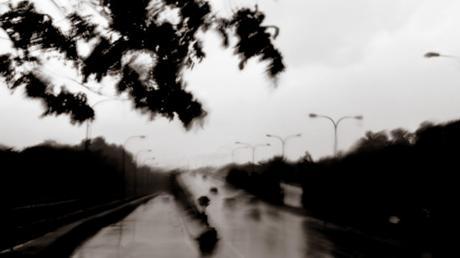
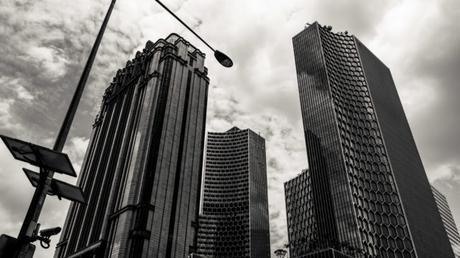
Music photography with the GFX
My professional work and my main passion is shooting music gigs. I did not find an opportunity during the past few days to shoot a music gig with the GFX. Also, the only wide angle lens available right now for the GFX is the 32-64mm F4 zoom and an aperture of 4 is not quite enough for dark nightclubs even at ISO 12,800. The 63mm F2.8 would be okayish, but I need a F2.8 or faster wide angle lens to pair with the 63mm to make a good low light music gig GFX setup.
My Fujifilm X-T2 is outstanding for shooting music, and maybe the most perfect camera ever, for me. Using the GFX would perhaps be somewhat overkill, but I have no doubt whatsoever that I CAN absolutely shoot music with the GFX! I have shots lots of music gigs with the X-Pro1 and X-T1 and the GFX is certainly no slower than those cameras. It is also just as kick ass at high iso as we have come to expect from Fujifilm X cameras. ISO 12,800 on the GFX looks as least as good as the X-Pro2/X-T2. So stay tuned for music gigs from me shot with the GFX, it will hopefully happen later this year. In the meantime, how about a Fake Record Cover Shoot?
Fake Record Cover ™ Shoot of Makaira

The one thing where I have always really wanted a medium format film camera is for shooting music portraits and record covers. Then, having that, I would only need a lot of jobs actually shooting record covers!
Fake it till you make it I say, and fortunately Makaira needed a record cover and PR shoot for her new EP The One That Got Away! Anton Corbijn is my hero and I am absolutely totally and completely ripping him off in this series. Heck, in a lot of stuff I do. Sorry Anton, fake it till you make it is my motto. I love how Corbijn uses falloff and out of focus to such incredible effect.
All the following images are shot almost entirely on manual focus and no they are not supposed to be “in focus”. I love manual focus, I love the imperfection it adds to an image, I want the images to come out a bit random and with flaws. I find that out-of-focus portraits look amazing on the GFX, that smooth silky falloff is gorgeous. These images are processed JPEGs. I crunched the blacks slightly in Lightroom and added a tint, but apart from that, the JPEGs out of the camera looked outstanding. I used all 3 lenses for this shoot and explored how medium format look and falloff can be used.
Oh and yes, we have a Fake Fish at the ready for a Fake Record Cover shoot. Of course.
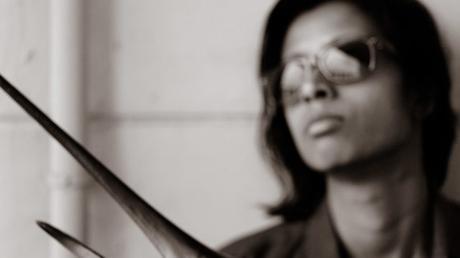
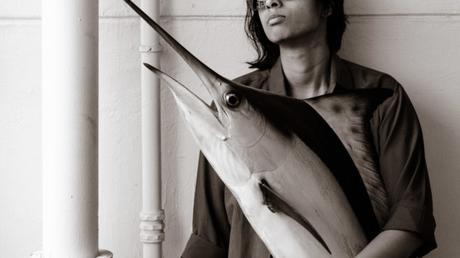
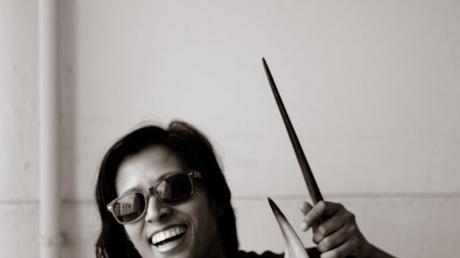

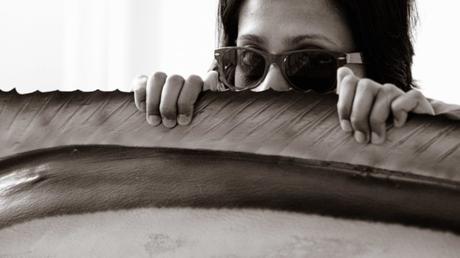
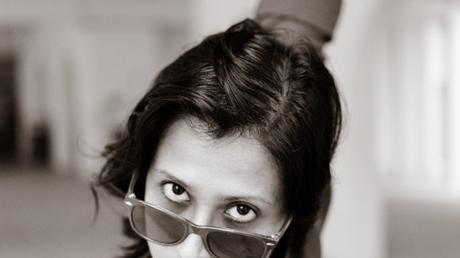

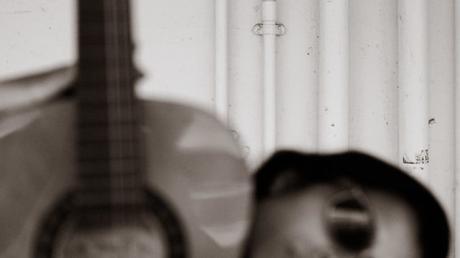
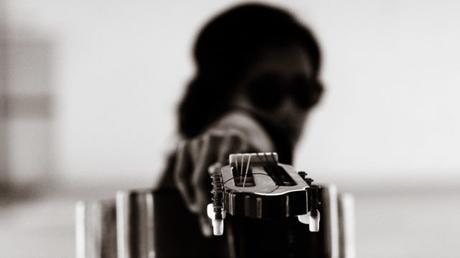
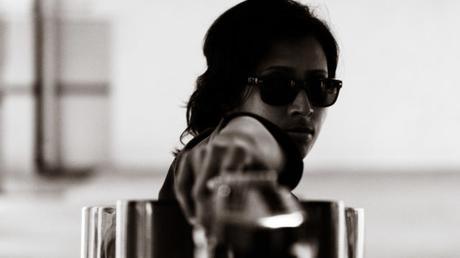
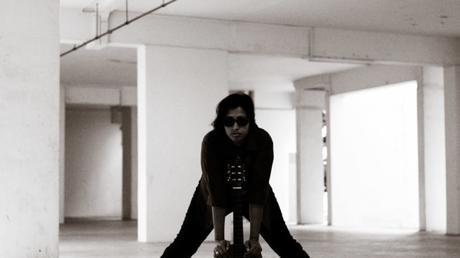
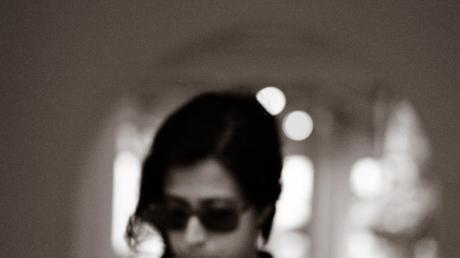
Random notes on using the GFX
- It took me 5 minutes or less to get started. Ok, not true, I had to charge the battery, but after that, if you are familiar with the Fujifilm X cameras this is a breeze to setup. It is like a big brother to the X-T2, the menu system is the same and most dials and buttons are too.
- The viewfinder. Holy moly! This is the best viewfinder. Ever. Large and very bright electronic viewfinder that is just a joy to use. I love the X-T2 viewfinder, but this is much larger and even better for me (old time-traveller here, old eyes, I need me a big viewfinder!). Love love love the viewfinder.
- First thing I did was change the file size to the panoramic 65:24 crop and the film simulation to ACROS and just walk around laughing myself silly as the giant viewfinder showed me this insanely cool black and white panoramic movie view of my world. Please, please please Fujifilm, put thet 65:24 crop mode into the X-T2 as well! Yes I know I can just crop later, BUT there is a huge advantage to actually being able to compose with this view, to actually see and not guess what I am doing. We have 1:1, 3:2 etc, why not 65:24 in the X-T2 as well – I want it bad!
- Where is the EV dial? This was the first thing that puzzled me. Boy do I miss an EV dial, I use the EV dial constantly on all the other X-cameras. I then figured out to set the back command dial as an EV dial and this helped greatly. But it is the one thing where the cameras differ greatly. 5 years of X-series muscle memory means my right thumb and index finger constantly reach for a non-existent EV dial.
- It is very quick and responsive. Pretty much like using an X-T1, with a longer blackout period – this will hopefully improve on next generation GFXes, maybe even with firmware updates for this one?
- I mostly used the 32-64mm F4 zoom lens as I like to shoot wide angle. It is a great lens, fast autofocus and as expected from Fujinon the image quality is a pure homerun. The 120mm I only used a tiny bit for the Fake Record Cover, it has a nice shallow DOF and falloff but far too heavy for me to carry around.
- Battery power is a lot better than I expected. We only had one battery each and were a little worried, but that one battery lasts for many hours of walking around and shooting, chimping, changing settings etc.
- The touch screen is really impressive, very quick and responsive.
- I have large hands and find The GFX quite comfortable and ergonomic to hold and I can reach all the buttons I need to quite easily. I much prefer small, lightweight cameras like my X-T2 and after a whole day of walking around Singapore with the GFX it starts to feel really heavy to me. But just the fact that a digital medium format can be this small, this compact, this light and this portable is truly remarkable.
Oh and this almost $9,000 dollar camera kit fits into my $5 bag!
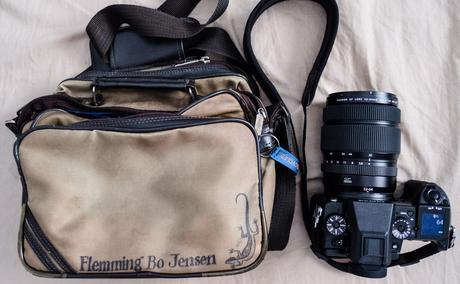
Nine Thousand Dollar camera meet Five Dollar Bag
Summary
It should be fairly obvious to you by now, that I have probably used the GFX in the “wrong” way every day. I am not a high end commercial shooter doing ad campaigns in a studio. But the fact that I did and could use the GFX in all kinds of random manner like I did is the whole trick – it is a highly versatile digital medium format camera!
After 5-6 days of shooting with the GFX, I find that this really is as flexible as any of the compact X-series cameras that I normally use. That is rather amazing for a digital medium format camera! To just sling it over the shoulder, take the train downtown and wander around for hours and snap some pictures. The image quality is incredible, and I have only used this handheld and mostly at high iso because that is how I shoot everything, and I often shoot at night. I am a continually broke nomad/time traveler and will never personally own a camera this expensive, but I AM excited about the medium format look and how versatile the GFX is. If I manage to loan a GFX again with a fast wide angle lens, I hope to shoot a music gig with it later this year – stay tuned!
(and call if you need a real record cover shoot, I can do them with the X-T2 as well! Fake Fish is extra).
A very big thank you to Fujifilm Singapore and especially Favian Loo for letting us goof around with 2 GFXes for a whole week. I am really humbled by this, thank you so much Favian. Also, thanks so much for the wonderful support and friendship to everyone at Fujifilm Nordic and Fujifilm Japan.
THE END feat GFX Selfie and Clouds
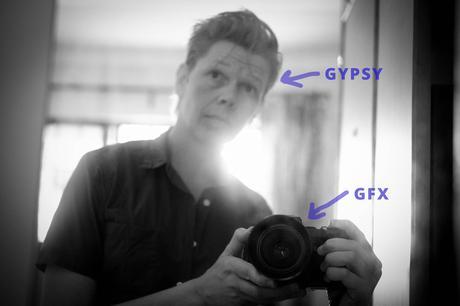
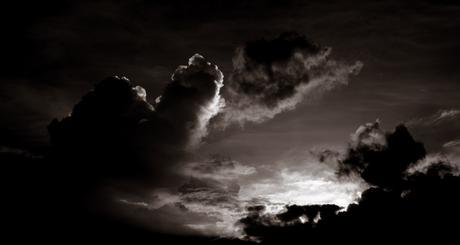
§

